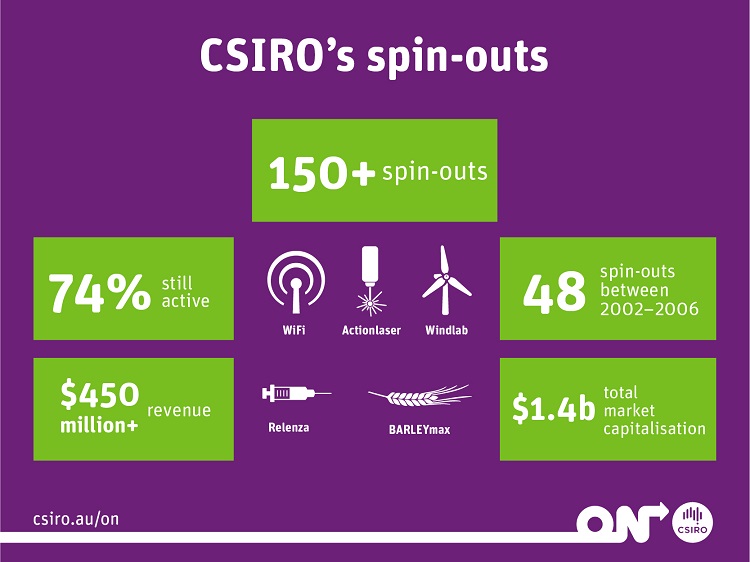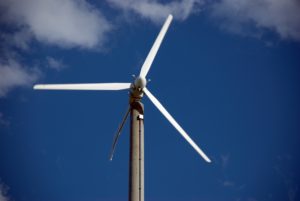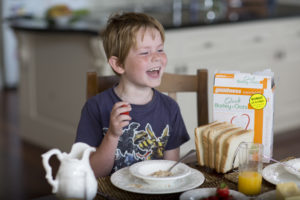We're taking a look at some of the commercial successes founded on CSIRO innovation.

Spin–out (noun \ˈspin-ˌout\) the creation of a separate company from part of an existing firm.
Startup (noun \ stahrt-uhp\) a new business venture, or a new commercial or industrial project.
As Australia’s manufacturing and resources industries slow down, technology startups are going to be critical in creating sustainable economic impact. Alan Noble, Engineering Director of Google ANZ, has said that tech startups could contribute $109 billion of GDP and add half a million jobs by 2033. That is massive!
The Australian startup ecosystem has come a long way. According to The 2015 Global Startup Ecosystem Report two-thirds of Australia’s startup activity takes place in Sydney. Australians have been known to be a talented bunch and this report confirms it with the lucky country ranking 6th out of 20 for access to high-value talent. But we’ve got work to do with our ecosystem value 80 times less that of Silicon Valley.
So, when you think spin-out or start-up, do you think of CSIRO?
Probably not, but that would be wrong. Did you know that we’ve spun out over 150 companies? That’s right, over 150! 26 of these were publicly listed, $1.4 billion total market capitalisation created and $450 million of revenue has been generated.
Below are just a few of our spinouts that have changed the way we live and work today.
- Wifi, anyone? The technology that is now critical in our connected lives was invented in Australia. It came out of our pioneering work in radio astronomy. The spinout company Radiata commercialised wireless networking technology (the early days of WiFi) and was bought by CISCO Systems in 2000 for $567m.

A picture of a wind turbine.
One of three wind turbines at the our Energy Centre, which generate a combined total 160 kw of power.
- Remember the H1N1 influenza virus? Our researchers were part of spin-out Biota Holdings Ltd which commercialised the drug Zanamivir. Licensed to GlaxoSmithKline as ‘Relenza’ it became a key treatment of the H1N1 influenza virus, as well as all strains of influenza virus including avian flu. Biota Holdings Ltd merged with a U.S. company and is listed on the NASDAQ.
- Where O where does the wind blow? Our researchers developed world-leading atmospheric modelling and wind energy assessment technology. What does this mean? WindLab’s WindScape technology identifies the most appropriate geographical areas for wind farms. We managed to double our investment in approximately eight years and the company went on to receive a substantial investment from LendLease.
- A grain of innovation. Spin-out The Healthy Grain Pty Ltd commercialised a low GI, high fibre, high resistant starch barley grain, BARLEYmax™. How will this impact you? Lower rates of diabetes, cardiovascular disease and colorectal cancer. Consumers have been able to enjoy the benefits of foods containing BARLEYmax™ since August 2009.

Enjoying breakfast to the BarleyMax.
- Smart buildings? We have it covered. Building IQ is an advanced, cloud-based software that reduces energy costs in commercial buildings. The core technology was originally developed with us. Backed by the likes of Siemens, Aster Capital, Schneider Electric, Alstom, and Paladin Capital Group, BuildingIQ grew its recurring revenue by 96 per cent in 2014. Entrepreneur Mike Zimmerman, who initially lead the spin-out of BuildingIQ, is now back with us looking for the next CSIRO invention to take to market.
It doesn’t stop there. We’re all about delivering the next innovation breakthrough that will change your life for the better. Our innovation program, ON, is doing this by actively building the connection between us and the existing entrepreneurial ecosystem.
We want you to help us bring the future ON. Connect with us.


5th November 2015 at 1:03 pm
Fantastic work CSIRO and great to see that a start-up ecosystem is developing in Australia. Would be good to see more of the CSIRO spin outs having more of a long lasting jobs and economic benefit for Australia and Australians as opposed to being sold off and lost overseas.
1st November 2015 at 8:22 pm
When I heard of the Ultrabattery I was very hopeful of a big revolution in battery construction and distribution.
What we got has been very disappointing.
CSIRO might benefit from better marketing and distribution contracts.
How many other poorly contracted ideas have been wasted?
2nd November 2015 at 2:18 pm
Hi Shaun, thanks for your feedback. The UltraBattery technology is now with an industry partner for commercial development. We’re now looking at new ways to create an enabling environment for products such as UltraBattery, for example through solar cooling. You might be interested in a recent report we completed for the Australian Energy Market Commission on the future of energy storage http://www.aemc.gov.au/News-Center/What-s-New/Preparing-markets-for-technological-change
31st October 2015 at 4:46 pm
smart buildings? hahaha! trying to build a house in 2015 you note that Australian builders are reluctant to even put double glass windows in and have not even heard of heat-exchange. Do you have anything better for your list? We don’t need fancy smartness as of yet. Just common sense for now and research should go into social science into how to break the inertia of the building sector and to outsmart those energy companies trying to sell more than less.
29th October 2015 at 5:30 pm
When I first read about BarleyMAX™ around 2011, I went straight to my local supermarket to get some; all they had was branded manufactured breakfast cereal containing just enough BM to make it legally advertizable and or the Sunrice® product containing Brown Rice + 20% BarleyMAX labelled “organic” contrary to the meaning established in the Science of Chemistry since around 1850. Moreover, whole-grain ordinary Barley sells for $3,50/kg, in contrast to the Sunrice® confection’s $10 or so. As the ordinary variety has just as spectacular an effect on Blood Lipids as claimed for the confection, equivalent to doubling one’s Simvastatin dose, why would any cost-conscious consumer switch to a BarleyMAX™ confection? Note: White spherical Pearl Barley is to whole-grain Brown Barley as Polished White Rice is to Brown Rice— Vitamin-free rubbish. Most manufactured breakfast cereal counts as Junk Food.
12th November 2015 at 4:56 pm
Hi Athro
Thanks for your comments.
We wanted to let you know that BARLEYmax™ is sold as an food ingredient by The Healthy Grain company (www.thehealthygrain.com).
Food companies such as Sunrice, combine the BARLEYmax™ ingredient with other ingredients to create healthy products.
Many food companies choose BARLEYmax as an ingredient, as it has a superior nutritional profile compared to many other grains (total dietary fibre, resistant starch, beta glucan and lower GI).
These nutritional attributes can assist food manufacturers to produce foods with the desired nutritional properties.
Best wishes
The Healthy Grain Company.